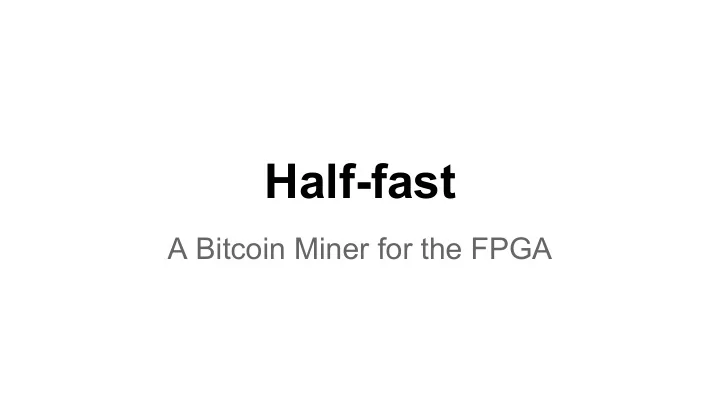

Half-fast A Bitcoin Miner for the FPGA
Overview ● Objectives and Motivation ● Bitcoin ● System Overview ● Hardware ● Software ● Challenges and Difficulties ● Lessons learned
Objectives and Motivation ● Build a Bitcoin miner on a FPGA board ● Mine block data from Bitcoin Network ● Parallelization
Bitcoin ● Bitcoin is an open source payment system based extensively on cryptographic hash functions ● Mining solves the problem of double spending through verifying transactions ● Transactions are public, but have no personal information ● Proof-of-work and mining pool
Proof-of-work ● Based on SHA-256 ● Must find a number which added to a hashed header will fit a certain number of zeros (difficulty) by incrementing a number called the nonce ● Hashes change drastically with a tiny modification, turning it into a very complex problem
Mining pool The mining pool is a process where multiple clients contribute to the solving of a block and share the rewards Work is organized by leader. Block data is sent to miners to attempt to solve
Mining Algorithm B = Block of Transactions D = Difficulty (part of B) 1) Construct/Modify B 2) If SHA256(SHA256(B, nonce)) < D End 3) nonce++; Goto 1
SHA256 Algorithm Message input M Divide M into 512-bit chunks, pad if necessary For each chunk Mi Compression(Mi) //bitwise shifting and rotation Accumulate into registers h0, h1, … h7 hash = {h0, h1, h2, …, h7}
System overview
System overview
Hardware implementation
FSM
Memory Map Interface input: output: clk readdata[7:0] reset write read chipselect writedata[7:0] address[7:0]
Miner Top
FPGA Miner* *Used an Open Source Miner. Modified it for our interface https://github.com/gardintrapp/Open-Source-FPGA-Bitcoin-Miner
SHA256 e0, e1, ch, maj, s0, s1 - bitwise operations LOOP parameter determines how many “digester” blocks are instantiated Big LOOP = less space, slower Small LOOP = more space, faster This is the Compression function unrolled K is array of constant values
Software implementation
getwork.c ● Userspace program written to facilitate communication between Mining pool and our FPGA miner ● Creates a getwork request to mining pool ● Sends the work down to the hardware with IOCTL calls defined in modified vga_led.c/h ● Separate threads reads and listens for solved work from fpga and new work from the mining pool
Challenges and difficulties ● Debugging hardware logic ● Writing scalable Verilog code ● Bookkeeping data and Simulating ● Learning the Bitcoin system
Lessons learned ● Be more thorough with initial planning/design process ● Simulate/Test carefully and thoroughly at each step of hardware implementation (ModelSim and System Console). Use scripts ● Start from Lab3 skeleton code ● Work on hardware and software in parallel ● Begin hardware software integration as early in development as possible
Half-fast: a Bitcoin miner for the FPGA Thank you!
Recommend
More recommend